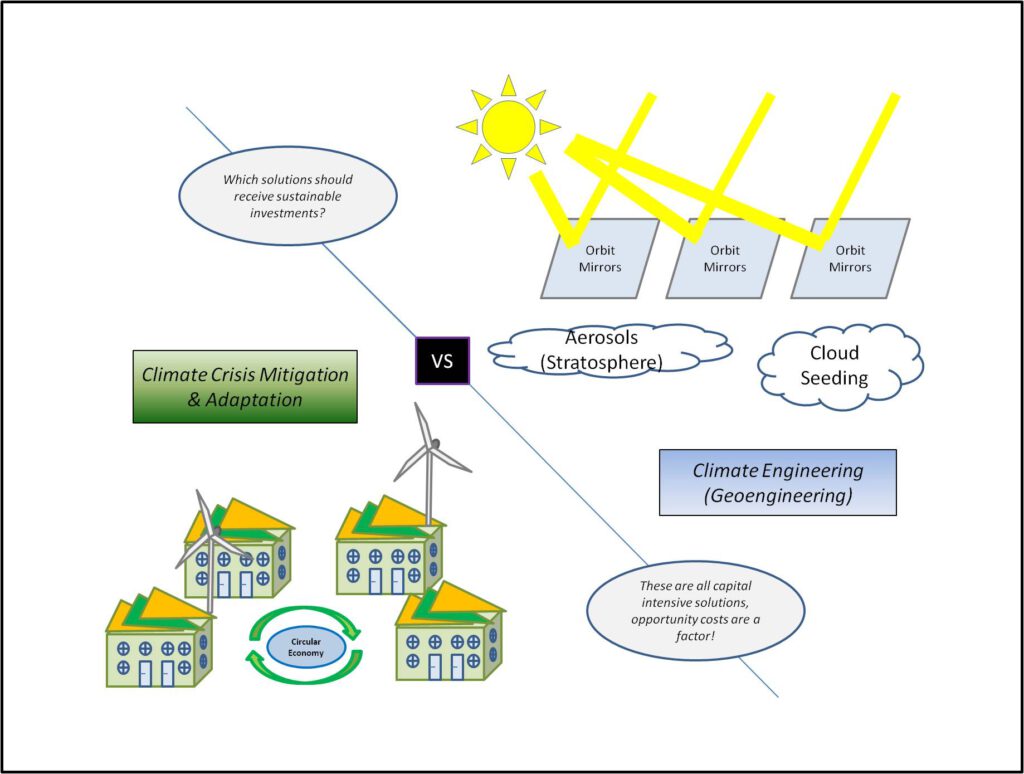January 2022
by Adrian Braun
Climate engineering (also known as geoengineering) is an umbrella term to comprise possible solutions to manipulate the climate in the upcoming decades, particularly to cool it down. It is controversially discussed as a strategy that could allow the global society and its governmental actors to remain on the path of high carbon emissions.
Multiple solutions are on the desks: There is for instance the installation of giant mirrors in the orbit to deflect the sunlight, simplified said just hindering solar radiation to reach the earth´s surface. Another solution could be stratospheric aerosol injection that would function like a global dimming (cooling) effect that naturally happens with volcanic eruptions temporarily. Sulphur or other aerosols could be released to the stratosphere with aircrafts and by doing this consistently, it could lead to cooling effects, while possible negative impacts are not fully predictable.
While there are many scientific publications available that would also highlight the scientific base for climate engineering much more in-depth, one thing is evident, many experts consider these solutions as misleading for good reason. The warming climate is not the only reason to have a need to reduce carbon emissions on the globe extensively. For example high carbon footprints cause negative impacts to the oceans as more greenhouse gases lead to changes in water temperature, acidification and deoxygenation in fragile and meaningful ecosystems.

Another obvious aspect is that all these solutions are linked to costs and most of them can be considered as capital intensive. For instance, installations of giant reflectors in the orbit are not feasible without massive budgets and maintenance in the long run would be required, too.
While the so to say already more traditional solutions for climate crisis mitigation and adaptation are definitely high as well, it seems like the governments on the globe have to sacrifice one for the other leading to the issue of having opportunity costs, what seems particularly serious when climate engineering solutions would be implemented, but at the same time other adverse effects of high carbon footprints are still impacting the planet and its flora, fauna and people.
Sustainable investments as often discussed on this website and around the activities of Arctic Values (particularly utilizing capital sources from institutional investors to combat the climate crisis) are crucial to make smart decisions, where the available capital should go to? Most scientists have a clear opinion in this regard and many distinguish climate engineering in contrast to “real” climate solutions, such as implementing renewable energies pr enabling forcing transitions to circular economy.
With the years passing by fast and major achievements in the climate crisis that relax the situation not really in sight, governments might be more and more tempted to turn towards climate engineering solutions, possibly framing it under the scope of “efficiency” and “technological advancements” that many global leaders promised to come in many climate conferences, notably in 2009 at COP 15 in Copenhagen, Denmark. Therefore, a situation may come up that climate engineering will be labelled as viable solution for sustainable investments, possibly just integrated into the novelized EU Taxonomy for Sustainable Finance in a few years. The question will be then, would the institutional investors jump on that train and provide their capital into financial instruments (possibly climate bonds or other debt securities) to finance reflectors in the orbit or constant sulphur injections to the stratosphere.
Eventually, the role of external experts and the provision of second opinions from consultants, NGOs and scientists just as it happens today already for many issuances of green and social bonds to verify the sustainability impact of an investment will be crucial and these have to be conducted transparently and independently to avoid that the whole sustainable investments concept will not sink into the abyss of greenwashing.
Legal Notice / Impressum – Arctic Values – Copyright © 2022